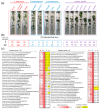The Omics Hunt for Novel Molecular Markers of Resistance to Phytophthora infestans
- PMID: 35009065
- PMCID: PMC8747139
- DOI: 10.3390/plants11010061
The Omics Hunt for Novel Molecular Markers of Resistance to Phytophthora infestans
Abstract
Wild Solanum accessions are a treasured source of resistance against pathogens, including oomycete Phytophthora infestans, causing late blight disease. Here, Solanum pinnatisectum, Solanum tuberosum, and the somatic hybrid between these two lines were analyzed, representing resistant, susceptible, and moderately resistant genotypes, respectively. Proteome and metabolome analyses showed that the infection had the highest impact on leaves of the resistant plant and indicated, among others, an extensive remodeling of the leaf lipidome. The lipidome profiling confirmed an accumulation of glycerolipids, a depletion in the total pool of glycerophospholipids, and showed considerable differences between the lipidome composition of resistant and susceptible genotypes. The analysis of putative resistance markers pinpointed more than 100 molecules that positively correlated with resistance including phenolics and cysteamine, a compound with known antimicrobial activity. Putative resistance protein markers were targeted in an additional 12 genotypes with contrasting resistance to P. infestans. At least 27 proteins showed a negative correlation with the susceptibility including HSP70-2, endochitinase B, WPP domain-containing protein, and cyclase 3. In summary, these findings provide insights into molecular mechanisms of resistance against P. infestans and present novel targets for selective breeding.
Keywords: Oomycetes; Oomycota; Phytophthora infestans; late blight; lipidome; metabolome; proteome; resistance; resistance markers.
Conflict of interest statement
The authors declare no conflict of interest.
Figures








Similar articles
-
Targeted and Untargeted Approaches Unravel Novel Candidate Genes and Diagnostic SNPs for Quantitative Resistance of the Potato (Solanum tuberosum L.) to Phytophthora infestans Causing the Late Blight Disease.PLoS One. 2016 Jun 9;11(6):e0156254. doi: 10.1371/journal.pone.0156254. eCollection 2016. PLoS One. 2016. PMID: 27281327 Free PMC article.
-
Screening of Wild Potatoes Identifies New Sources of Late Blight Resistance.Plant Dis. 2021 Feb;105(2):368-376. doi: 10.1094/PDIS-06-20-1367-RE. Epub 2020 Dec 30. Plant Dis. 2021. PMID: 32755364
-
Development of somatic hybrids Solanum × michoacanum Bitter. (Rydb.) (+) S. tuberosum L. and autofused 4x S. × michoacanum plants as potential sources of late blight resistance for potato breeding.Plant Cell Rep. 2013 Aug;32(8):1231-41. doi: 10.1007/s00299-013-1422-5. Epub 2013 Mar 24. Plant Cell Rep. 2013. PMID: 23525760 Free PMC article.
-
Interspecific somatic hybrids Solanum villosum (+) S. tuberosum, resistant to Phytophthora infestans.J Plant Physiol. 2013 Nov 15;170(17):1541-8. doi: 10.1016/j.jplph.2013.06.013. Epub 2013 Aug 28. J Plant Physiol. 2013. PMID: 23993778
-
Lysophosphatidylcholine 17:1 from the Leaf Surface of the Wild Potato Species Solanum bulbocastanum Inhibits Phytophthora infestans.J Agric Food Chem. 2021 May 26;69(20):5607-5617. doi: 10.1021/acs.jafc.0c07199. Epub 2021 May 14. J Agric Food Chem. 2021. PMID: 33988025
Cited by
-
Interaction With Fungi Promotes the Accumulation of Specific Defense Molecules in Orchid Tubers and May Increase the Value of Tubers for Biotechnological and Medicinal Applications: The Case Study of Interaction Between Dactylorhiza sp. and Tulasnella calospora.Front Plant Sci. 2022 Jun 30;13:757852. doi: 10.3389/fpls.2022.757852. eCollection 2022. Front Plant Sci. 2022. PMID: 35845638 Free PMC article.
-
Differences in the Proteomic and Metabolomic Response of Quercus suber and Quercus variabilis During the Early Stages of Phytophthora cinnamomi Infection.Front Microbiol. 2022 Jun 13;13:894533. doi: 10.3389/fmicb.2022.894533. eCollection 2022. Front Microbiol. 2022. PMID: 35770156 Free PMC article.
-
Characterization and Potential Role of Fatty Acid-Solamine Conjugates in Plant Defense against Herbivores and Pathogens in Wild Potato Species.J Agric Food Chem. 2025 Jun 4;73(22):13555-13567. doi: 10.1021/acs.jafc.5c01297. Epub 2025 May 25. J Agric Food Chem. 2025. PMID: 40413644 Free PMC article.
-
Bunyaviruses Affect Growth, Sporulation, and Elicitin Production in Phytophthora cactorum.Viruses. 2022 Nov 22;14(12):2596. doi: 10.3390/v14122596. Viruses. 2022. PMID: 36560602 Free PMC article.
-
Defense mechanisms promoting tolerance to aggressive Phytophthora species in hybrid poplar.Front Plant Sci. 2022 Oct 13;13:1018272. doi: 10.3389/fpls.2022.1018272. eCollection 2022. Front Plant Sci. 2022. PMID: 36325556 Free PMC article.
References
Grants and funding
LinkOut - more resources
Full Text Sources
Molecular Biology Databases

